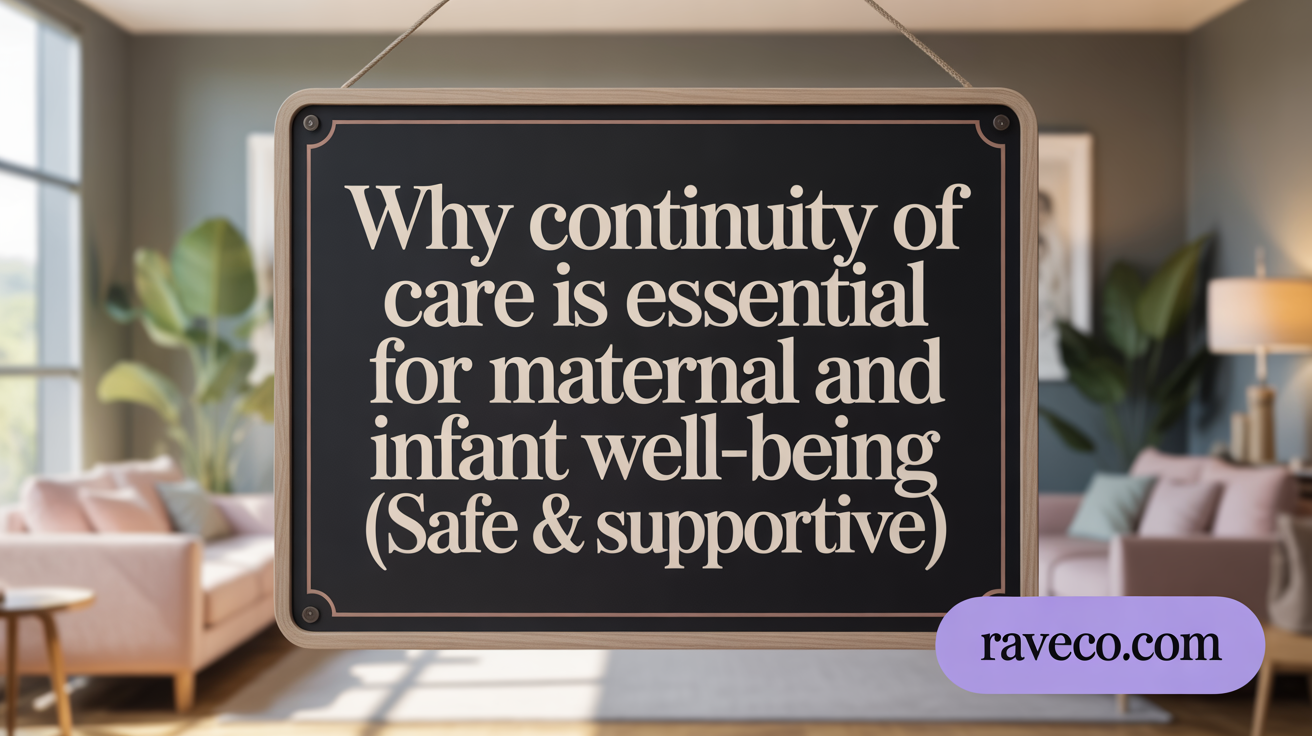Recognizing the Right Time to Address Female Infertility: Key Indicators and Expert Care in Queens

Understanding Continuity of Care in Maternity Services
Continuity of care is a cornerstone of high-quality maternity services, emphasizing an ongoing, trusting relationship between a pregnant woman and her healthcare provider. This approach ensures personalized, coordinated care throughout pregnancy, labor, and postpartum, significantly improving maternal and infant health outcomes. This article explores why delivering your baby with your own doctor or midwife matters, focusing on the benefits, models, challenges, and strategies that empower women and promote safer, more satisfying birth experiences.
Defining Continuity of Care and Its Dimensions in Maternity

What is continuity of care?
Continuity of care is an approach that emphasizes consistent, ongoing healthcare tailored to an individual’s needs over time. It involves maintaining a trust-based relationship between patients and providers, ensuring seamless communication, and coordinated management across different stages and settings. This concept covers three main aspects: informational continuity, management continuity, and relational continuity.
Informational continuity involves the effective use of patient history and data to inform decisions and provide personalized care. Management continuity ensures that care plans are coherent and consistent across various healthcare providers and over time, avoiding fragmentation. Relational continuity is about developing a sustained, trusting relationship between the patient and care provider, which can improve engagement, satisfaction, and health outcomes.
High-quality continuity of care not only enhances patient safety but also leads to better health results and can reduce healthcare costs by minimizing unnecessary interventions and hospitalizations.
What are the three types of continuity of care?
The three primary forms of continuity are informational, management, and relational.
- Informational continuity involves sharing relevant health data and history among healthcare providers so they can make informed decisions and provide cohesive care.
- Management continuity guarantees that treatment strategies and care approaches stay consistent over time, adapting appropriately to changing needs.
- Relational continuity focuses on building an ongoing, trustworthy relationship that enhances communication and understanding between the patient and healthcare providers.
These types work together to create a comprehensive and patient-centered healthcare experience, particularly vital in maternity services where personalized, consistent care can significantly influence birth experiences, maternal health, and infant outcomes.
Why Continuity Matters: Positive Impacts on Maternal and Infant Health

Why is continuity of care important in maternity services?
Continuity of care in maternity services is vital because it builds a trusting relationship between women and their care providers. This consistent connection allows midwives and healthcare professionals to gain a deep understanding of each woman's unique needs, preferences, and concerns. Such enduring relationships improve the quality of care and support women in making informed choices about their pregnancy and birth experience. Research shows that continuity reduces the likelihood of unnecessary interventions like cesarean sections and increases overall satisfaction.
Having a familiar provider during pregnancy also fosters emotional safety, which can help women feel more confident and less anxious. Continuous care encourages open communication, where women feel comfortable discussing sensitive topics such as mental health, fears, or past trauma. In turn, this personalized approach promotes better health education, more tailored guidance, and ultimately, better health outcomes for both mother and baby.
How does continuity of care positively impact maternal and infant health outcomes?
Continuity of care contributes significantly to improved health outcomes for mothers and their infants. When healthcare providers can monitor a woman’s health over time, they are better equipped to detect early signs of complications, such as preterm labor, infections, or hypertension. Early intervention can prevent the development of more serious issues, ensuring safer pregnancies.
Furthermore, sustained support from qualified professionals, such as midwives, increases the likelihood of spontaneous vaginal births and reduces the risk of adverse events. Women who experience ongoing care also report higher levels of satisfaction and emotional well-being, which are linked to healthier pregnancies. Consistent relationships promote adherence to health recommendations, including breastfeeding and postnatal care, further enhancing infant health.
Evidence from research
A wealth of research supports the positive influence of continuity of care. The World Health Organization highlights that midwifery-led models can prevent over 60% of maternal and neonatal deaths when implemented universally. The 2024 Cochrane review confirms that women in continuous midwife-led care are less likely to undergo interventions like cesarean births, report higher satisfaction levels, and experience care that is as safe as traditional obstetric models.
Studies from countries like Australia, Canada, and Ireland show that women receiving continuous midwifery care tend to have fewer preterm births and higher rates of breastfeeding. Additionally, evidence demonstrates that ongoing relationships with healthcare providers promote trust and emotional safety, leading to better birth experiences and mental health outcomes.
In sum, consistent, personalized care throughout pregnancy and childbirth not only enhances safety but also fosters empowerment and satisfaction, fundamentally improving maternal and infant health.
| Effect Area | Benefits | Supporting Evidence |
|---|---|---|
| Maternal health | Fewer interventions, improved mental health, higher satisfaction | Cochrane review, WHO data |
| Infant health | Lower preterm birth, higher breastfeeding rates | International studies ( |
Australia, Canada, Ireland) | | Healthcare system | Reduced complications, lower costs, fewer hospital stays | Research on continuity models worldwide |
The accumulated evidence underscores that maintaining ongoing relationships with care providers is integral to safer, more satisfying maternity care, with broad benefits for individuals and health systems alike.
Relational Continuity: Building Trust and Emotional Safety for Women

How does relational continuity between women and healthcare providers influence birth experiences?
Relational continuity between women and healthcare providers, especially midwives, creates trust and emotional support that enhance positive birth experiences. This ongoing relationship enables personalized care and shared decision-making, empowering women to feel more in control and reducing fears. Such continuity is linked with fewer interventions, improved outcomes, and increased satisfaction by fostering a safe, respectful birth environment.
Role of relational continuity
Continuity in care means that women regularly see the same care provider during pregnancy, birth, and postpartum. This consistency helps the provider understand the woman's unique needs, preferences, and concerns.
Emotional and psychological benefits
Women who experience relational continuity often report feeling more emotionally supported and understood. The familiarity and trust built over time can alleviate anxiety, promote confidence, and enhance overall well-being during childbirth.
Empowerment during childbirth
A continuous relationship promotes a sense of empowerment. Women are more likely to participate actively in decisions about their birth options, express their wishes, and feel respected.
Enhancing shared decision-making
Trust fosters open communication. When women trust their care provider, they are more comfortable discussing fears and preferences, leading to collaborative decision-making and tailored care plans that reflect their wishes.
This sustained relationship not only improves the immediate birth experience but also sets a foundation for better postpartum support, child health, and family satisfaction, emphasizing the importance of continuity as a core aspect of reproductive and maternity healthcare.
Midwife-Led Continuity Models vs Other Care Models: Benefits and Considerations

What are the benefits of midwife-led continuity of care models compared to other models?
Midwife-led care offers a comprehensive, woman-centered approach that supports women throughout pregnancy, childbirth, and postpartum. This model emphasizes natural, physiologic birth and aims to minimize medical interventions whenever safe and possible. Women receiving midwife-led continuity care often report higher satisfaction levels, feeling more supported and empowered during their birthing experience.
Research shows that midwife-led models are associated with favorable outcomes such as lower rates of cesarean sections, instrumental deliveries, and episiotomies. Additionally, these models tend to promote better breastfeeding initiation and continuation. The consistent presence of the same provider nurtures trust, providing emotional safety and enabling women to openly discuss concerns or fears.
However, some studies suggest a slight increase in risks for certain adverse outcomes compared to obstetric-led care, especially in high-risk pregnancies. This highlights the importance of appropriate risk stratification and integrated care systems. Overall, midwife-led continuity models are considered safe and effective for low-risk pregnancies, with benefits extending into improved maternal wellbeing and satisfaction.
Comparison with obstetric-led models
Traditional obstetric-led care often involves multiple providers and less consistent contact, which can impact trust and communication. While medical interventions are readily available when needed, this sometimes results in higher intervention rates and a less personalized experience.
In contrast, midwife-led models emphasize personalized, holistic care, fostering stronger relationships that are conducive to emotional and physical wellbeing. The focus is on supporting natural labor processes, promoting normalcy, and reducing unnecessary interventions.
Holistic and woman-centered approach
Midwives prioritize understanding each woman's unique needs, preferences, and social context. This approach involves continuous emotional support, extensive education, and shared decision-making that empower women during their birthing journey.
Furthermore, midwifery care often includes education on parenting, nutrition, and family health, extending benefits to the entire family unit. The relationship built through ongoing contact positively influences birth experiences, reduces postnatal depression, and enhances satisfaction.
Limitations and safety considerations
Despite the many benefits, midwife-led care is not suitable for all pregnancies, especially those with high medical risks such as pre-existing health conditions or complications. The model requires robust referral systems and collaborative care with obstetric specialists to ensure safety.
Some concerns about safety margins exist, although recent evidence and systematic reviews demonstrate that, when well-implemented, midwifery models are as safe as traditional obstetric care for low-risk women.
Continuous evaluation, clear guidelines, and integrated health services are essential to maximize safety and effectiveness.
| Aspect | Benefits | Considerations | Additional Details |
|---|---|---|---|
| Maternal outcomes | Lower intervention rates, higher satisfaction | Risk management for high-risk pregnancies | Supported by Cochrane and WHO evidence |
| Psychological well-being | Empowerment, reduced postnatal depression | Not suitable for high-risk or complex cases | Emphasizes emotional and informational support |
| Family involvement | Positive impact on families, better family health | Requires adaptations for different familial contexts | Supports holistic family health |
| Safety | Safe for low-risk pregnancies | Need for risk stratification and collaboration | Studies show safety when protocols followed |
Understanding the overall benefits and limitations helps inform care choices and health policy, ensuring women receive the most appropriate and respectful maternity care.
Challenges and Barriers to Implementing Continuity of Care in Maternity Services
What barriers exist to implementing continuity of care in midwifery?
Implementing continuity of care in maternity services faces multiple hurdles. One of the primary challenges is workforce shortages. Many regions experience a lack of enough trained midwives to provide personalized, continuous care across the entire reproductive cycle. Staffing issues, including inconsistent coverage and high turnover, make it difficult to maintain sustained relationships with women.
Organizational and systemic barriers also play a significant role. Healthcare systems are often driven by fragmentation, which complicates efforts to provide consistent care. Structural resource constraints, such as limited funding, inadequate infrastructure, and insufficient staffing models, hinder the implementation of continuity practices.
Professional hierarchies within healthcare settings can obstruct midwives’ ability to operate autonomously or advocate for continuity models. In some environments, rigid hierarchies empower obstetricians over midwives, limiting collaborative efforts and shared decision-making.
Cultural and normative factors, including gender norms and organizational cultures that do not prioritize relational continuity, further complicate reform efforts. Policies may lack specific support for continuity of care, and existing regulations might not incentivize or facilitate the development of dedicated continuity models.
To address these barriers, systemic reforms are essential. Leadership commitment and policy development can pave the way for sustainable change. Strategies such as increasing training opportunities, restructuring staffing arrangements, fostering collaborative cultures, and adopting flexible care models are vital for overcoming these obstacles.
Strategies for Effective Continuity of Care: Supporting Families and Health Systems
What strategies and principles support effective implementation of continuity of care in maternity services?
Implementing continuity of care in maternity services relies on several core principles and strategies. Building consistent relationships between women and their care providers is fundamental. This allows for personalized support, emotional safety, and trust, which are crucial during childbirth and postpartum periods.
Clear and ongoing communication plays a vital role. Structured handoff protocols, timely sharing of information, and face-to-face or digital interactions ensure all team members are updated and aligned. Using shared electronic health records facilitates seamless information flow, enabling providers to recognize subtle health changes early and intervene appropriately.
Multidisciplinary collaboration enhances care quality. Models like caseload midwifery or integrated care teams promote close coordination, ensuring that women receive comprehensive support throughout pregnancy, birth, and postpartum.
Leadership and organizational strategies are essential to address systemic hurdles such as staffing shortages, regulatory constraints, and resource limitations. Establishing small, dedicated teams within larger systems can maintain personal contact and accountability.
Cultural sensitivity and patient education also strengthen continuity efforts. Tailoring care to diverse populations, especially those facing social and structural barriers—such as racial disparities in maternal health—can improve equity and outcomes.
Technology tools are increasingly vital. Digital platforms for sharing health information, virtual consultations, and online support networks support flexible communication and continuous engagement.
By combining these principles—relationship building, clear communication, collaborative teamwork, and technology—health systems can create reliable, patient-centered maternity care that benefits women, infants, and providers alike.
Why Continuity Truly Counts for Your Birth Experience
Choosing to deliver your baby with your own doctor or midwife is more than a convenience—it's a profound investment in safety, trust, and personalized care that influences both your health and your baby's. Continuity of care ensures a deep understanding of your unique needs, consistent monitoring, and emotional support that together contribute to healthier outcomes and a more satisfying birth journey. Despite challenges in implementation, evidence overwhelmingly supports continuity as a best practice in maternity care. By fostering ongoing relationships, integrating technology, and overcoming systemic barriers, healthcare systems can offer families the quality and compassion they deserve. For every expectant mother, continuity counts — because your birth experience should be as individualized and supported as the life you are bringing into the world.
References
- Why continuity of care matters for your child's health | Penn Medicine
- Continuity, consistency, and care access: Reimagining what's ...
- Midwives and Continuity of Care: Why It Matters
- The woman's birth experience—The effect of interpersonal ...
- Does continuity in general practice really matter? - PMC
- Family Physicians Delivering Babies? It's Time to Decide
- Childbirth experience in women participating in a continuity of ...
- Continuity of Care Is Associated With High-Quality Careby Parental ...





.png)